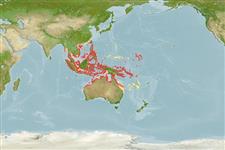Common names from other countries
>
Eupercaria/misc (Various families in series Eupercaria) >
Nemipteridae (Threadfin breams, Whiptail breams)
Etymology: Scolopsis: Greek, skolex = worm + Greek, opsis = appearance (Ref. 45335).
More on author: Cuvier.
Environment: milieu / climate zone / depth range / distribution range
экология
морской ассоциированный с рифами; пределы глубины 2 - 25 m (Ref. 9785). Tropical; 24°N - 27°S, 94°E - 172°E (Ref. 3810)
Western Pacific: South China Sea to Vanuatu and northwestern Australia.
Size / Вес / Возраст
Maturity: Lm ? range ? - ? cm
Max length : 28.0 cm TL самец/пол неопределен; (Ref. 9710); common length : 15.0 cm SL самец/пол неопределен; (Ref. 3810)
колючие лучи спинного плавника (общее число): 10; членистые (мягкие) лучи спинного плавника (общее число): 9; колючие лучи анального плавника 3; членистые (мягкие) лучи анального плавника: 7. Head scales reaching to or almost to posterior nostrils. Lower limb of preopercle scaly. Antrorse (forward-directed) suborbital spine absent. Pelvic fins long, reaching almost to or beyond level of origin of anal fin. Color: Upper body olive, white below. 2 pearly white stripes on snout in front of eyes. Lower lobe of caudal fin reddish. Juveniles white, with a narrow black stripe along back (only on some specimens) and black midlateral stripe. Some with a yellowish ventral surface. Presence of a black spot between first four dorsal spines. Some color variation between Indian and Pacific populations: juveniles lack yellow stripe in the Indian Ocean population and adults show a contrasting dark back compared to Pacific form (Ref. 48635).
Found on sand bottoms close to reefs. Feed on crustaceans, polychaete worms, mollusks and small fishes (Ref. 3810, 9785). Juveniles may be Batesian mimics of poison-fang blennies, Meiacanthus spp. (M. geminatus and M. vittatus) (Ref. 37816, 90102). It is parasitised by the monogenean Anoplodiscus hutsonae on the pectoral fins and body surface (Ref. 124057).
Life cycle and mating behavior
половая зрелость | размножение | нерест | икра | Fecundity | личинки
Russell, B.C., 1990. FAO Species Catalogue. Vol. 12. Nemipterid fishes of the world. (Threadfin breams, whiptail breams, monocle breams, dwarf monocle breams, and coral breams). Family Nemipteridae. An annotated and illustrated catalogue of nemipterid species known to date. FAO Fish. Synop. 125(12):149p. Rome: FAO. (Ref. 3810)
Статус Красного Списка МСОП (Ref. 130435)
CITES (Ref. 128078)
Not Evaluated
Угроза для людей
Harmless
Использование человеком
рыболовство: рыболовство как средство для существования
дополнительная информация
ссылкиаквакультура (рыбоводство)особенности рыбоводствастепень растяжениягенетикаElectrophoresesнаследуемостьболезниобработкаMass conversion
соавторыизображенияStamps, Coins Misc.звукиCiguateraскоростьтип плаванияжаберная областьOtolithsмозгзрение
инструменты
Специальные отчеты
Скачать в формате XML
ресурсы в Интернет
Estimates based on models
Preferred temperature (Ref.
115969): 26.7 - 29.3, mean 28.7 (based on 1950 cells).
Phylogenetic diversity index (Ref.
82804): PD
50 = 0.5000 [Uniqueness, from 0.5 = low to 2.0 = high].
Bayesian length-weight: a=0.01995 (0.01105 - 0.03604), b=3.01 (2.86 - 3.16), in cm Total Length, based on LWR estimates for this species & Genus-body shape (Ref.
93245).
Trophic level (Ref.
69278): 3.6 ±0.52 se; based on food items.
устойчивость к внешним воздействиям (Ref.
120179): высокий, минимальное время удвоения популяции до 15 месяцев (Preliminary K or Fecundity.).
Fishing Vulnerability (Ref.
59153): Low vulnerability (18 of 100).
